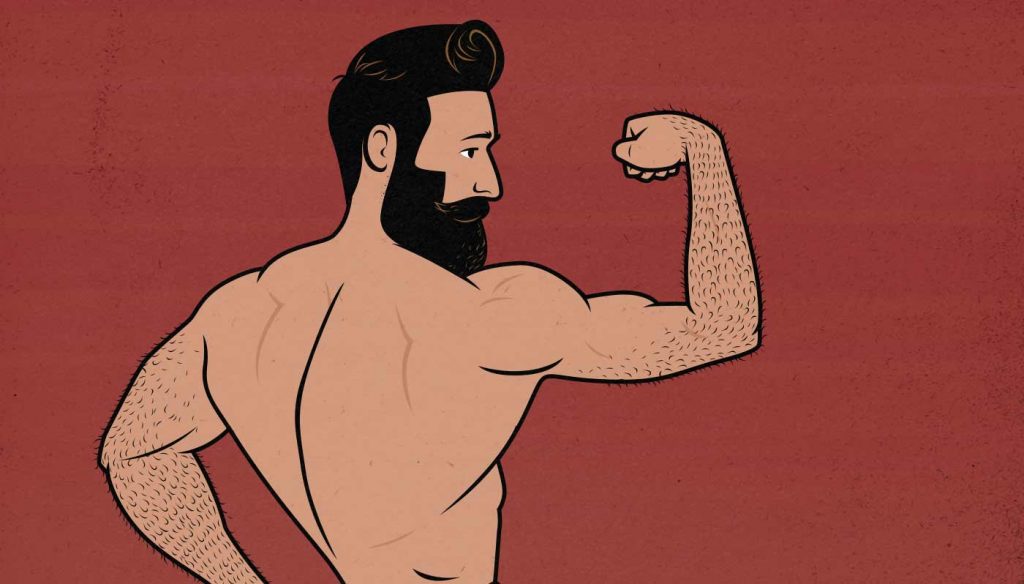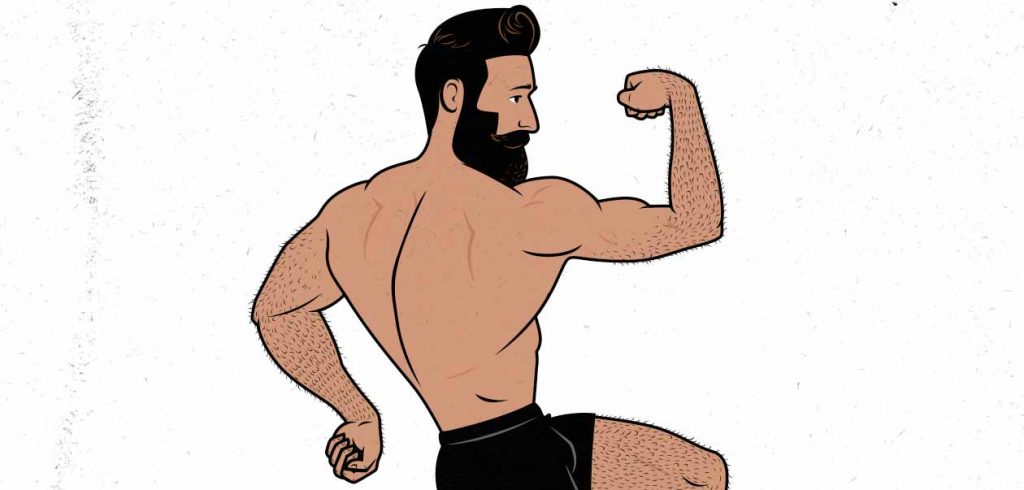
Should You Double Down on Strengths Or Bring Up Weaknesses?
In this article, let’s talk about the philosophy you should adopt while choosing your lift variations and accessories. Should you run lift with your strengths and focus on what you’re best at? Or should you address your weaknesses so that you can build a more balanced and versatile physique?
What’s interesting is that the answer changes depending on your goals. Doubling down on strengths will make you stronger, bringing up weaknesses will make you look better, and a mix of both approaches tends to be best for general health.
We’ve chosen the Big 5 Bulking Lifts because of how good they are at building a physique that’s muscular, strong, and aesthetic. However, no matter how well you do those lifts, and no matter how strong you get at them, your body will develop some quirks. Some muscles will grow big and strong, others will lag behind.
That brings up some important questions. Should you double down on your strengths, choosing lifts that make your dominant muscles even stronger? After all, that’s probably going to help you get the strongest at your lifts. Or should you bring up your weaknesses, choosing lifts that bring your lagging muscles back into balance. That’s going to make you look better, but if those muscles aren’t active in the big compound lifts, it might not make you much stronger.
You’re also going to notice that some lifts feel much better than others, and that you have a much easier time getting better at them. Should you double down on those strengths, putting more of your effort into the lifts that benefit you the most? Or should you try to get better at the lifts that you’re struggling with in order to develop a more versatile physique?
Let’s go over the pros and cons of both approaches.
Stay Loyal to The Lifts That Love You
We all have lifts that feel great and work well for us. Do more of that. Make those lifts bedrocks in your routine.
If you love the barbell bench press, it helps you build a fearsome chest, and it feels great on your shoulders, then it doesn’t matter if the dumbbell bench press is, on average, better for building up your chest. If you prefer the barbell variation, run with it as far as you can. (Which probably isn’t very far. We aren’t an endurance site. But you know what I mean.)
Same thing with the back squat, pull-up, or whatever else. Yeah, maybe another lift is better for most people. But who cares? You should be choosing the lifts that work best for you.
Now, that doesn’t mean you shouldn’t try other lifts. If you love pull-ups and here we come recommending chin-ups, eh, maybe give them a try. After all, we know what we’re talking about (most of the time). Maybe you only suck at chin-ups because your biceps suck, and by switching to chin-ups, you’ll be giving your biceps a better growth stimulus. But if you try them out for a few weeks and they don’t work for you, meh, no big deal. We’re all different. Stay loyal to the lifts that love you.
By that same token, if the lifts you’re doing aren’t working out well for you, you don’t need to stay faithful to them. You should always feel free to adjust your technique, use different variations, or experiment with different rep ranges. And if that doesn’t work, sometimes a break-up is in order. If the barbell bench press messes with your shoulders, stop doing it. Find another chest exercise that makes your body feel strong. Marry that one instead.
For Strength, Strengthen Weak Links
If you want to get stronger at a given lift, you don’t need to worry about lagging muscles, just find the weak link and bring it up. This is the powerlifter approach to training, when you aren’t seeking balance, you’re just seeking to improve your strength on specific lifts.
Let’s say you’re trying to increase your strength on the bench press, and you notice that your chest is lagging behind. Perhaps when you fail the bench press, it’s because your shoulders give out. Maybe your chest doesn’t even get sore after benching. That’s probably because your chest isn’t the prime mover that you’re relying on. Maybe you’re relying on your shoulders instead.
In this case, your chest is struggling. It’s weak. It’s not even contributing properly to the lift. Does that mean you should come to its rescue? No. If you’re seeking strength, don’t let yourself get distracted by the weak, the meek, or the lazy. Those muscles are irrelevant to your goals.
Yes, if you strengthen you chest, it might help a little bench press a bit more weight, sure, but chances are that your chest just doesn’t have great leverage in the movement. Maybe you’re just built that way. You just aren’t chest-dominant bencher.
In this example, it’s your shoulders that are your dominant pushing muscles. It’s your shoulders that are shouldering the load, and so even though they’re already proportionally strong, it’s still your shoulders that are bottlenecking your results. Your shoulders are the weak link. And so you’ll probably do a better job of improving your bench press if you double down on your shoulders, bulking them up even more.
If you’re training for strength, balance doesn’t matter. You lift with your strengths, so invest in those strengths.
For Aesthetics, Bring Up Lagging Muscles

If you want to build an aesthetic physique, find the muscles that aren’t being built by your main lifts, and bring them up with accessory lifts. This is the bodybuilder approach to training. When you bulk up those muscles, it won’t necessarily help you lift more weight, but it will help you build a more balanced and aesthetic physique.
Let’s use the same example from the previous section: your bench press isn’t growing your chest. Except this time, let’s say that your main goal isn’t to improve your bench press strength, but rather, your main goal is to build a balanced physique complete with a powerful chest.
In this case, you’ll want to choose exercises that will help bring up your lagging chest. Maybe you want to add a pause to your barbell bench press or switch to the dumbbell bench press. Maybe you want to choose accessories that bring up your chest, such as chest flyes, pec deck, and low-incline bench presses.
For General Health, Seek Balance
If your goal is to become big, strong, and healthy in a general sense, then you’ll want to become strong at all movements. That goes beyond just being able to bench press a bunch of weight, it also includes having pressing muscles that are strong in a versatile way. So do the barbell bench press, dumbbell bench presses, overhead presses, skull crushers, and chest flyes. Try to bring up lagging muscles, and to improve at movements that you’re weak at.
Training for general strength has a lot in common with training for aesthetics. That’s because aesthetics is essentially just how fit and formidable we look—especially in our upper bodies. The distinction, though, is that aesthetics don’t have to do with how much we can bench, squat, dead, or chin, it has to do with how strong we appear in a far more general sense.
For example, perhaps you can bench press 315 pounds, which is certainly a formidable bench press. However, if you bench with your shoulders and triceps, perhaps you still have a fairly small chest. It’s unlikely (study), but it can happen. In that case, you can probably improve your aesthetics by bringing up your lagging chest, whether or not that makes your bench press any stronger.
For a different example of this, general health is closely linked to our grip strength (study) as well as our aesthetics (study). That doesn’t mean we should intentionally train our grip, though, it just means that someone who is generally strong will tend to have a strong grip, look better, and live longer. The traits are developed together.
If your muscles are big, full, round, and generally well-developed, then you’ll tend to look and perform better. That doesn’t mean just getting strong at compound lifts, though, it means getting strong at everything.
Now, don’t get me wrong. The big compound lifts are the most efficient way to get strong at everything. With a lift like the deadlift, for example, grip strength is just a small part of the lift. Yet if you can build a big deadlift, then your grip will necessarily grow strong along the way.
Still, though, if you notice that some muscles or movements are lagging behind, you’ll benefit from addressing those imbalances with different lift variations and accessory exercises. Don’t abandon the deadlift, just take your quirks into account when programming it.
Remember the first principle, too. Stay loyal to the lifts that love you, and distance yourself from the lifts that hate you. If a particular variation makes your tendons or joints feel bad, get rid of it. If another variation makes you feel great, do more of it.
If you’re in this for the long haul—and you probably should be—then you need to make sure that your lifting program is building you up stronger, not gradually wearing you down. The last thing you want to do is lift hard for ten years, develop cranky joints, and then be forced to lift like an old man. That’s going to make it much harder to stay strong and healthy as you age.
There are many different ways to build your muscles, so as you experiment with different lifts and techniques, keep track of which approaches feel best for you as an individual.
Key Takeaways
There are a few different ways to choose your lift variations and accessories, depending on your goals:
- To improve your strength: if you’re trying to improve your strength at a lift, take notice of which muscle group is failing. That’s your weak link. Strengthen it. For example, if you can’t get the barbell of your chest because your pecs are too weak, then you might want to use flyes to strengthen your chest.
- To improve your aesthetics: if you’re trying to improve your aesthetics, then you’ll probably want to bring up any muscle groups that are lagging behind, especially in your upper body. For example, if your chest is dominant in the bench press, maybe your shoulders and triceps start to lag behind, so you might be able to improve your appearance with extra overhead pressing.
- To improve your general health: if you’re lifting to improve your general health, it’s important to choose lifts that feel good on your joints, allow you to gain size and strength, and that you enjoy. However, also be mindful of overall balance. It’s good to use a wide variety of lifts that make you strong in a wide variety of movements.

If you want a customizable workout program (and full guide) that builds these principles in, then check out our Outlift Intermediate Bulking Program. If you liked this article, you’ll love the full program.


